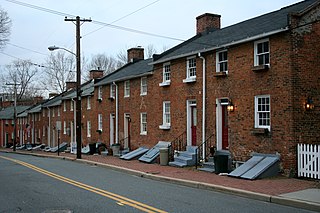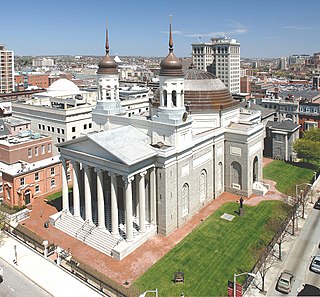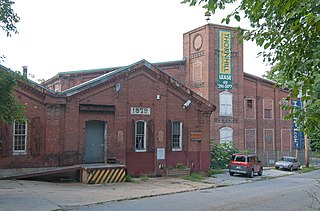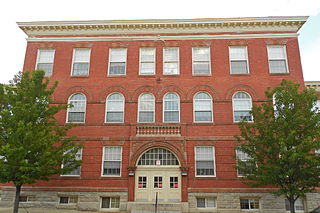
Hampden is a neighborhood located in northern Baltimore, Maryland, United States. Roughly triangular in shape, it is bounded to the east by the neighborhood Wyman Park, to the north by Roland Park at 40th and 41st Street, to the west by the Jones Falls Expressway, and to the south by the neighborhood Remington. The Homewood campus of the Johns Hopkins University is a short distance to the east.

Druid Hill Park is a 745-acre (3.01 km2) urban park in northwest Baltimore, Maryland. Its boundaries are marked by Druid Park Drive (north), Swann Drive and Reisterstown Road, and the Jones Falls Expressway / Interstate 83 (east).

Oella is a mill town on the Patapsco River in western Baltimore County, Maryland, United States, located between Catonsville and Ellicott City. It is a 19th-century village of millworkers' homes.

The Phoenix Shot Tower, also known as the Old Baltimore Shot Tower, is a red brick shot tower, 234.25 feet (71.40 m) tall, located near the downtown, Jonestown, and Little Italy communities of East Baltimore, in Maryland. When it was completed in 1828 it was the tallest structure in the United States.

The Bollman Truss Railroad Bridge across the Little Patuxent River at Savage, Maryland, is one of the oldest standing iron railroad bridges in the United States and the sole surviving example of a revolutionary design in the history of American bridge engineering. The 160-foot (48.8 m) double-span was built in 1852 at an unknown location on the main line of the Baltimore and Ohio Railroad. It was moved 35 years later to its present location, where it replaced the very first Bollman bridge. Today, it carries the Savage Mill Trail.

The Patterson Viaduct was built by the Baltimore and Ohio Railroad (B&O) as part of its Old Main Line during May to December 1829. The viaduct spanned the Patapsco River at Ilchester, Maryland. It was heavily damaged by a flood in 1868 and subsequently replaced with other structures. In 2006, it was restored to limited service when a footbridge was built atop the surviving arch and abutments.

Woodberry is a neighborhood located in the north-central area of Baltimore, Maryland, USA. A largely residential, middle-class area, Woodberry is a historic community bordered on the north by Cold Spring Lane, on the south by Druid Hill Park, on the west by Greenspring Avenue, and on the east by the Jones Falls Expressway and the Jones Falls. Woodberry is located within Postal Zip code 21211.

London Fog is an American manufacturer of coats and other apparel. The company was founded in 1922 as the Londontown clothing company by Israel Myers.

The Cathedral Hill Historic District is an area in Baltimore, Maryland. It lies in the northern part of Downtown just south of Mount Vernon. Roughly bounded by Saratoga Street, Park Avenue, Hamilton Street, and St. Paul Street, these 10 or so blocks contain some of the most significant buildings in Baltimore. The area takes its name from the Basilica of the Assumption which sits in the heart of the district. Despite the number of large religious structures in the area, the district's buildings are primarily commercial in character, with a broad collection of significant commercial structures ranging in date from 1790 to 1940.

The Avondale Mill was a large gable-front stone structure, three stories in height, and 10 bays long by three wide. It was located on the bank of the Patuxent River in the city of Laurel, Prince George's County, Maryland. It was constructed in 1844–1845 for Captain William Mason & Son of Baltimore. It was complemented by the neighboring Laurel Mill built in 1811, S.D. Heath's machine shop, and Richard Israel's flouring mill. At that time it was provided with the machinery for the manufacture of fine cloth, running as many as 1,500 cotton spindles with 150 employees. In 1845, industrialist Peter Gorman was responsible for the first macadamized (paved) road in Laurel, Avondale Street next to the new Mill.

Silver Spring station is a former train station on the Metropolitan Subdivision in Silver Spring in Montgomery County, Maryland. It was built in 1945 by the Baltimore and Ohio Railroad on the foundation of a previous station, a Victorian-style brick structure built in 1878. It served intercity trains until 1986 and commuter rail until 2000. Today, it is owned and operated as a museum by Montgomery Preservation, Inc., a non-profit organization.

The Owings Upper Mill is a historic grist mill located at Owings Mills, Baltimore County, Maryland, United States. It is a large 3+1⁄2-story brick structure, 50 by 60 feet. The building stands on a low stone foundation, surmounted by a molded brick water table. Two frame extensions were built sometime in the 1880s. The words "EUREKA FLOUR MILL" are worked into the façade in purple brick between the second- and third-story windows. The building is probably the oldest and largest mill surviving in Baltimore County and was the last known project of Samuel Owings, the American Revolutionary War patriot and enterprising merchant.

American Ice Company Baltimore Plant No. 2 is a historic ice manufacturing plant located at Baltimore, Maryland, United States. It consists of two industrial buildings: an original two story stone ice manufacturing building built in 1905 and a brick ice storage addition, built in 1919, is an immense, nearly windowless structure with the height of a six-story building.

H.F. Miller & Son Tin Box and Can Manufacturing Plant, or the American Can Company, Miller Factory, and now Miller Court is a historic can manufacturing plant located at Baltimore, Maryland, United States. It was erected in three stages between 1890 and about 1910. It is a four-story brick manufacturing plant. The exterior features decorative brickwork, multiple window forms, and substantial construction typical of the period. The interior features chamfered posts, closely spaced joists, and fire doors.

Mount Vernon Mill No. 1 is a historic cotton mill complex located at Baltimore, Maryland, United States. It was constructed between 1873 and 1918 and consists of four buildings situated along Jones Falls. The complex consists of three closely associated 19th-century buildings and a 20th-century warehouse. There is a large, three-story brick Mill Building (1873); a two-story, brick, L-shaped Picker House (1873); a two-story, brick Store House ; and a later, reinforced-concrete warehouse (1918). It served as headquarters for Mount Vernon-Woodberry Mills, one of the world's largest producers of cotton duck.

Montgomery Ward Warehouse and Retail Store is a historic warehouse and retail building in Baltimore, Maryland, United States. It is an eight-story concrete structure and is roughly shaped like a squared-off number "4". The front features a penthouse tower at the main entrance bay with a balcony and capped by a flagpole. The building houses over 1,200,000 square feet (110,000 m2) of floor space flooded by light from approximately 1,000 large multi-paned, steel frame windows. It was built about 1925 as a mail order and retail warehouse for Montgomery Ward on an 11 acres (4.5 ha) site adjacent to the Baltimore and Ohio Railroad tracks. The complex was one of nine large warehouses built by the company in the United States.

Brick Hill is a national historic district in Baltimore, Maryland, United States. It is a small, isolated enclave neighborhood of 2- and 2+1⁄2-story masonry duplexes constructed about 1877 to house workers in the nearby Meadow Mill of the Woodberry Manufacturing Company. All but one of the eleven duplexes are constructed of brick, hence the four-acre enclave's traditional name; the other dwelling is built of stone. Two small two-story frame houses are also included in the district.

Poole and Hunt Company Buildings refers to a complex of buildings that once housed an ironworks— consisting of a foundry, machine shop, blacksmith shop, erecting shop, and other structures, which were located in the Woodberry section of northwest Baltimore, Maryland, United States. The buildings, made chiefly of brick and fieldstone, occupied portions of a 20-acre site. They were constructed beginning in 1853 and enlarged periodically as the business of manufacturing iron-based parts and machinery expanded. [Poole and Hunt refers to the partners Robert Poole (1818-1903) and German H. Hunt (1828-1907).] In 1973, although the buildings had been converted to other uses, they remained intact and that year were added to the National Register of Historic Places. In 1995, a major fire destroyed the machine shop, damaged parts of other buildings, and stopped further activity in the balance of the site. After 2000, real estate developers purchased the former industrial site and converted the buildings into commercial and residential uses. The complex is now known as Clipper Mill.

Franklin Square Historic District is a national historic district in Baltimore, Maryland, United States. It is a 19th-century rowhouse neighborhood developed along a strict grid street pattern. A one square block, two and a half acre public park, Franklin Square, is a focal point for the area and the most elaborate rowhousing surrounds the square. The district contains approximately 1,300 buildings of which approximately 1,250 contribute to the significance of the historic district.

Caves Valley Historic District is a national historic district near Owings Mills, Baltimore County, Maryland, United States. It is located in a natural upland valley encompassing about 2,100 acres (8.5 km2) along the North Branch of the Jones Falls and its contributing courses. It includes cultivated fields, pastures, woodlands, streams, housing clusters, and agricultural structures. The vernacular buildings are log, stone, and frame, reflecting the local materials and functional plans of rural locations in the 18th and 19th centuries.

























